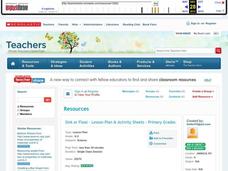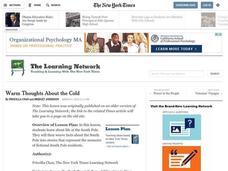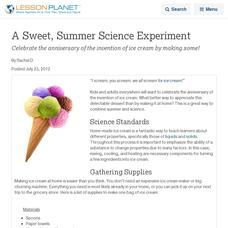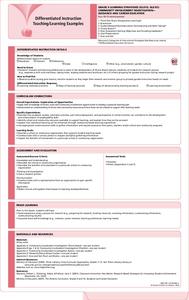Curated OER
Sink or Float
Using a variety of objects, learners conduct buoyancy experiments. They make predictions on which object will sink or float and test their predictions. They use a graphic organizer to record their findings.
NASA
Just How Far is That Star?
Pupils often wonder how we know the distance to various stars. Starting with a thought experiment and progressing to a physical experiment, they determine the brightness and distance to various stars. The evaluation requires critical...
Constitutional Rights Foundation
History of Immigration Through the 1850s
Everyone living in the United States today is a descendant from an immigrant—even Native Americans. Learn about the tumultuous history of American immigration with a reading passage that discusses the ancient migration over the Bering...
Astronomical Society of the Pacific
Getting Ready for the All American Eclipse!
Give your pupils a front row seat at the biggest light show in the sky this year! In addition to admiring the total solar eclipse, young astronomers can explain the phenomenon with a little help from an inquiry-based lesson. The focus of...
Curated OER
The Lipstick Experiment
In this scientific method instructional activity, students read "The Lipstick Experiment" and then complete the 2 student tasks on the instructional activity. They then answer the 5 questions regarding what they just read. The answers...
Curated OER
Experience: referring to an activity in the unspecified past
In this past experience activity, students refer to activities in the past by filling in blanks to sentences such as was, have been, thought, and more. Students complete 22 multiple choice questions.
Curated OER
Design Your Own Biological Experiment
Students work together to research a topic of interest to them. They form hypothesis and complete experiments testing them. They present their findings to the class.
Curated OER
Warm Thoughts About the Cold
“What do you think life is like at the South Pole?” After responding to this journal prompt, class members read and discuss the New York Times article, “At South Pole, New Home for a New Era.” Using resources available from the Times’...
Curated OER
Lesson: Double Album: Sentence as Thought
The cut-up technique invented by surrealist artist Tristan Tzara is the focus for today. Young artists examine the technique and analyze its use in relation to expressing and viewing the world. They then use a newspaper to create a...
Curated OER
A Sweet, Summer Science Experiment
Celebrate the anniversary of the invention of ice cream by making some!
Curated OER
Tapping into the Experiences of Senior Citizens
Through casual talk and structured interviews, 6th graders tap into the wealth of their senior pals' experiences. They write descriptive essays and narratives based on conversations with relatives or neighbors. They read selected...
Intensive Intervention
Fractions as Numbers
Your learners will enjoy thoroughly understanding fractions, and you will appreciate the abundant, quality resources in this comprehensive unit that builds toward a complete understanding of the concept of fractions as numbers. Many...
Carolina K-12
Doing Democracy
How do you explain democracy to a middle school classroom? A social studies resource breaks elections and the democratic process down for your class. Discussion questions, worksheets, activities that build critical thinking skills, and a...
Core Knowledge Foundation
Farms Tell It Again!™ Read-Aloud Anthology
The thematic read-aloud anthology introduces young readers to life on a farm. The thoughtfully detailed resource offers three weeks of skills practice designed to boost reading comprehension skills. Lessons follow a routine of...
Novelinks
The Giver: Guided Imagery
Guide your class through the imagery of Lois Lowry's The Giver with a peaceful meditative experience. After you create a serene environment in your class, read through a provided script in which kids sift through their favorite memories...
Macmillan Education
Get Thinking
Have a go at this exercise in thinking by asking thinkers to think about thinking, of what they think of, and what they think about. The worksheets in the packet provide much food for thought.
Odell Education
Scientific Process and Experimental Design
The scientific method keeps you from believing only what you want to believe — it expands your mind. The lesson introduces the eight steps in the scientific process and how to design an experiment to biology scholars. Live insects...
EduGAINs
Community Involvement Investigation— Guidance and Career Education
Not only do extracurricular activities look good on a college application, they can foster important life skills. From sports to volunteering to employment, extracurricular activities can inform your learners' experiences later in life....
Mathematics Vision Project
Module 1: Getting Ready Module
This fabulous resource is a must-have for any algebra teacher's arsenal of lessons. Developing the idea of equations and use of variables from basic physical scenarios, learners gain valuable intuition in the structure and meaning of...
It's About Time
Elements and Compounds
Young scientists use electrolysis to separate water into its elements before experimenting with fire to learn about their properties. A helpful resource provides a reading passage and analysis questions.
Curated OER
Scale Activities
How do you put something as large as the universe in perspective? Use a series of scale experiments. Classmates collaborate around four experiments to examine the scale of the earth-moon system, our solar system, the Milky Way galaxy,...
Berkshire Museum
Nature Journaling: Experience the Outdoors Through Writing and Drawing
Step into the great outdoors and develop young scientists' skills of observation with a nature journaling lesson. Given a specific focus or goal, children practice making and recording observations of nature through written descriptions...
S2tem Centers SC
Seasons
Winter, spring, summer, and fall—take the learning of the seasons beyond the elementary level to the middle school classroom. Curious learners begin by watching videos about the seasons and the rotation of planet Earth. Then, they...
Teaching Tolerance
Civic Engagement and Communication as Digital Community Members
Don't feed the Internet trolls! Using a thought-provoking resource, pupils brainstorm a whole-class list of the possible kinds of bias young people may experience online. Next, in small groups, scholars create posters illustrating how to...

























